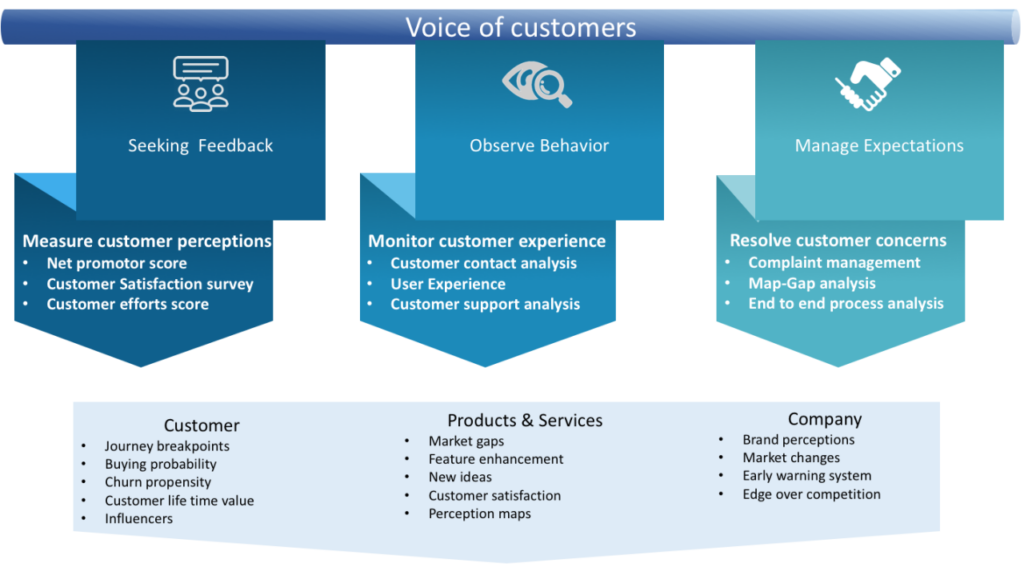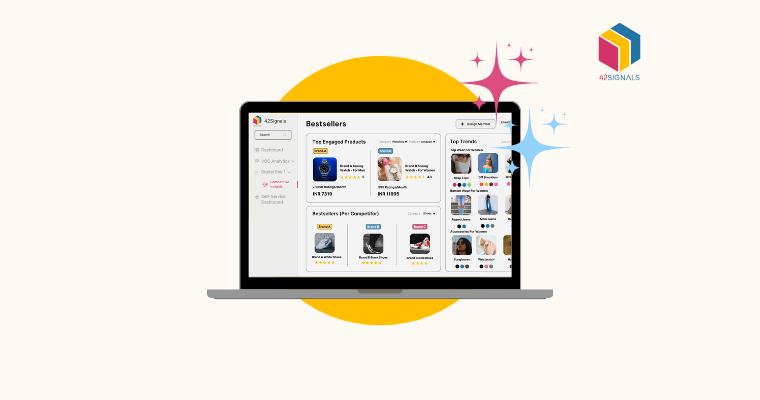In a world that never stops sprinting, understanding what makes your customers tick is pure gold. But let’s face it, coaxing customers into pouring out their unfiltered thoughts isn’t exactly a walk in the park. And even if they did, figuring out what to do with their feedback and experience can be tricky. This is where Voice of Customer (VoC) analytics steps in as a game-changer.
Voice of Customer analytics empowers businesses to tap into the invaluable feedback from their customers, transforming it into actionable insights. Today, you can utilize VoC tools for insights that help your business identify trends, pain points, and areas for improvement; ultimately boosting customer satisfaction, loyalty, and growth.
But how do you choose the best tool when there’s a plethora of options catering to every industry? Fret not. In this blog, we’ll shed light on the significance of VoC analysis, compare some of the top tools available in the market, and help you discover the premier choice for your business. So let’s dive right in!
Why is Voice of Customer Analytics Important?
The era of one-size-fits-all marketing and product development has long passed. Today, customers seek personalized experiences, and VoC analytics helps businesses meet these expectations. By capturing and dissecting customer feedback, businesses gain a profound understanding of what their customers truly desire.
When it comes to e-commerce, a good VoC tool helps you map out the journey your customers take – from browsing to checkout. This treasure map of e-commerce insights reveals where customers might be getting lost or where they’re happily following the trail. Fix those pain points, and you’ll have a shopping experience worth remembering.
Moreover, Voice of Customer tools are more than just data collectors; they’re feedback alchemists. They transform raw feedback data into actionable insights. Text analytics and sentiment analysis technologies decode the language of customer feedback. This helps you address service gaps, fine-tune brand management, optimize product offerings, and create effective marketing strategies. It’s not just about staying afloat; it’s about thriving by aligning with your customers’ needs.

Source: LinkedIn Pulse
Exploring the Landscape: A Comparison of Voice of Customer Analytics Tools
The selection of a VoC tool needs careful consideration of various aspects. Evaluating user-rated tools, examining user interface, usability, data visualization, integrations, and pricing can guide you toward an informed choice. The objective is to enhance product management, unlock customer satisfaction, and achieve an optimal product-market fit. With the right VoC tool, businesses are poised to make strides in delivering unparalleled customer experiences. So let’s look at some of the best customer analytics tools available today.
SurveySparrow:
Picture this: You want to ask your customers a thing or two, but you don’t want them snoozing halfway through. Enter SurveySparrow! SurveySparrow engages customers through conversational surveys, enhancing response rates. And guess what? It offers mobile-optimized and customizable themes, making surveys visually appealing. With features like NPS tracking and responsive support, SurveySparrow provides a holistic solution. It’s worth noting that while its casual format is excellent for general surveys, it might not suit specialized ones.
Survicate:
When was the last time you got excited about an email survey? Well, Survicate sure knows how to change that! They specialize in email survey feedback collection and have customizable surveys with over 150 templates. This makes the surveys look visually appealing – enticing customers and promising better response rates. And their email survey game? On point! However, the limitations in their CRM integration and deleted survey recovery are worth considering.
InMoment:
Real-time feedback and AI-driven insights are InMoment’s forte. In simpler words, it’s like having customer thoughts on speed dial. And its advanced analytics and sentiment analysis elevate its capabilities. They’re like X-ray vision for your data. Plus, they cater to a lot of different industries like retail, healthcare, food services, financial services, travel & hospitality, automotive, and more. However, the customization options for surveys and reporting features are somewhat limited.
Brandwatch:
Social media is like a galaxy of customer opinions. And Brandwatch is your trusted companion to navigate through it all. Backed by 17 years of AI development, its sentiment analysis and visualizations are highly effective. The Voice of Customer Analytics by Brandwatch makes your content marketing activities more relevant which promises better ROI. However, the absence of multilingual support can be a major drawback.
Medallia:
If you’ve got feedback pouring in from emails, calls, and social media websites, trust Medallia to swoop in, gather it all, and turn it into easy-to-understand actionable insights. With AI-powered analytics, real-time feedback monitoring, and even a comprehensive customer journey map, it’s like having a personal feedback wizard. While all this is extremely helpful, it’s important to note that its survey design options and export functionalities are somewhat restricted.
42Signals:
Among these powerful contenders, 42Signals clearly emerges as a standout option in the Voice of Customer analytics category. It effortlessly unveils the most relevant topics within millions of product reviews to bridge the gap between products and their audience. Imbued with AI-ML algorithms, it dissects consumer details across platforms, identifying opinions and sentiments.

42Signals’ ingenious machine learning algorithms scrutinize reviews, all while asking important questions that give valuable insights into consumer behavior. The best part is that you gain insights at granular levels, helping you align with competitors and gauge user intent. All in all, a complete package that elevates VoC analytics to new heights.
A Glimpse of Other Alternatives
While these are some of the best Voice of customer analytics tools, the landscape of VoC tools is brimming with alternatives that cater to various needs. Tools like MonkeyLearn, Qualtrics XM, SurveyMonkey, and more, each bring their unique strengths to the table. Choose MonkeyLearn for AI-driven sentiment analysis, Qualtrics XM for some serious CX analytics, and SurveyMonkey for flexible survey designs. However, it’s crucial to evaluate their specific features and pricing models to ensure they align with your business requirements.
Conclusion
So, there you have it, the inside scoop on these VoC analytics tools. Remember, it’s all about finding the one that fulfills your unique business needs. In a landscape where customer-centricity is paramount, Voice of Customer analytics can help you truly resonate with your buying customer. The journey toward customer excellence begins with the right VoC tool – a tool that transforms feedback into growth and customers into brand advocates. Are you ready to take that transformative step?
And if you’re ready to take your business to the next level, reach out to the experts at 42Signals today!
For more details, or to schedule a demo today!




